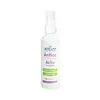What's inside
What's inside
 Key Ingredients
Key Ingredients

 Benefits
Benefits

 Concerns
Concerns

 Ingredients Side-by-side
Ingredients Side-by-side

Water
Skin ConditioningAloe Barbadensis Leaf Juice
Skin ConditioningGlycerin
HumectantCaprylyl/Capryl Wheat Bran/Straw Glycosides
CleansingMelaleuca Alternifolia Leaf Oil
AntioxidantLecithin
EmollientZinc PCA
HumectantBisabolol
MaskingP-Anisic Acid
MaskingCalendula Officinalis Extract
Skin ConditioningChamomilla Recutita Flower/Leaf Extract
AntimicrobialHippophae Rhamnoides Kernel Extract
MaskingLavandula Angustifolia Oil
MaskingRosmarinus Officinalis Leaf Oil
MaskingMentha Piperita Oil
MaskingCitrus Aurantium Dulcis Peel Oil
MaskingEucalyptus Globulus Leaf Oil
PerfumingTocopheryl Acetate
AntioxidantCetearyl Glucoside
EmulsifyingFusel Wheat Bran/Straw Glycosides
EmulsifyingPhenoxyethanol
PreservativeLimonene
PerfumingBenzyl Alcohol
PerfumingDecyl Glucoside
CleansingGlyceryl Caprylate
EmollientPolyglyceryl-5 Oleate
EmulsifyingSodium Cocoyl Glutamate
CleansingLinalool
PerfumingCitral
PerfumingGeraniol
PerfumingAlcohol
AntimicrobialArginine
MaskingGlyceryl Laurate
EmollientPolyglyceryl-3 Caprylate
EmulsifyingPolyglyceryl-4 Caprate
EmulsifyingWater, Aloe Barbadensis Leaf Juice, Glycerin, Caprylyl/Capryl Wheat Bran/Straw Glycosides, Melaleuca Alternifolia Leaf Oil, Lecithin, Zinc PCA, Bisabolol, P-Anisic Acid, Calendula Officinalis Extract, Chamomilla Recutita Flower/Leaf Extract, Hippophae Rhamnoides Kernel Extract, Lavandula Angustifolia Oil, Rosmarinus Officinalis Leaf Oil, Mentha Piperita Oil, Citrus Aurantium Dulcis Peel Oil, Eucalyptus Globulus Leaf Oil, Tocopheryl Acetate, Cetearyl Glucoside, Fusel Wheat Bran/Straw Glycosides, Phenoxyethanol, Limonene, Benzyl Alcohol, Decyl Glucoside, Glyceryl Caprylate, Polyglyceryl-5 Oleate, Sodium Cocoyl Glutamate, Linalool, Citral, Geraniol, Alcohol, Arginine, Glyceryl Laurate, Polyglyceryl-3 Caprylate, Polyglyceryl-4 Caprate
Salicylic Acid 2%
MaskingWater
Skin ConditioningPropanediol
SolventGlycerin
HumectantNiacinamide
SmoothingZinc PCA
HumectantSalix Alba Bark Extract
AstringentGlycyrrhiza Glabra Root Extract
BleachingCitric Acid
BufferingAloe Barbadensis Leaf Juice Powder
Skin ConditioningEpilobium Fleischeri Flower/Leaf/Stem Extract
Skin ConditioningRosmarinus Officinalis Leaf Extract
AntimicrobialSodium Hydroxide
BufferingPPG-1-PEG-9 Lauryl Glycol Ether
EmulsifyingCoceth-7
EmulsifyingPEG-40 Hydrogenated Castor Oil
EmulsifyingCitrus Grandis Seed Extract
AstringentCitrus Aurantium Dulcis Peel Extract
Emulsion StabilisingCitrus Limon Peel Extract
EmollientPolydextrose
HumectantDextrin
AbsorbentAmylopectin
Chlorphenesin
AntimicrobialEthylhexylglycerin
Skin ConditioningPhenoxyethanol
PreservativeTocopherol
AntioxidantPanthenol
Skin ConditioningParfum
MaskingCoumarin
PerfumingSalicylic Acid 2%, Water, Propanediol, Glycerin, Niacinamide, Zinc PCA, Salix Alba Bark Extract, Glycyrrhiza Glabra Root Extract, Citric Acid, Aloe Barbadensis Leaf Juice Powder, Epilobium Fleischeri Flower/Leaf/Stem Extract, Rosmarinus Officinalis Leaf Extract, Sodium Hydroxide, PPG-1-PEG-9 Lauryl Glycol Ether, Coceth-7, PEG-40 Hydrogenated Castor Oil, Citrus Grandis Seed Extract, Citrus Aurantium Dulcis Peel Extract, Citrus Limon Peel Extract, Polydextrose, Dextrin, Amylopectin, Chlorphenesin, Ethylhexylglycerin, Phenoxyethanol, Tocopherol, Panthenol, Parfum, Coumarin
Ingredients Explained
These ingredients are found in both products.
Ingredients higher up in an ingredient list are typically present in a larger amount.
Glycerin is already naturally found in your skin. It helps moisturize and protect your skin.
A study from 2016 found glycerin to be more effective as a humectant than AHAs and hyaluronic acid.
As a humectant, it helps the skin stay hydrated by pulling moisture to your skin. The low molecular weight of glycerin allows it to pull moisture into the deeper layers of your skin.
Hydrated skin improves your skin barrier; Your skin barrier helps protect against irritants and bacteria.
Glycerin has also been found to have antimicrobial and antiviral properties. Due to these properties, glycerin is often used in wound and burn treatments.
In cosmetics, glycerin is usually derived from plants such as soybean or palm. However, it can also be sourced from animals, such as tallow or animal fat.
This ingredient is organic, colorless, odorless, and non-toxic.
Glycerin is the name for this ingredient in American English. British English uses Glycerol/Glycerine.
Learn more about GlycerinPhenoxyethanol is a preservative that has germicide, antimicrobial, and aromatic properties. Studies show that phenoxyethanol can prevent microbial growth. By itself, it has a scent that is similar to that of a rose.
It's often used in formulations along with Caprylyl Glycol to preserve the shelf life of products.
Water. It's the most common cosmetic ingredient of all. You'll usually see it at the top of ingredient lists, meaning that it makes up the largest part of the product.
So why is it so popular? Water most often acts as a solvent - this means that it helps dissolve other ingredients into the formulation.
You'll also recognize water as that liquid we all need to stay alive. If you see this, drink a glass of water. Stay hydrated!
Learn more about WaterZinc PCA (or "zinc salt") differs slightly from zinc itself. PCA stands for pyrrolidone carboxylic acid. However, Zinc PCA comes from zinc.
It can help reduce redness, regulate sebum, and promote the general healing process of the skin.
Zinc PCA tends to be especially useful for those with oily, acne-prone skin. It's certainly an ingredient worth trying out!
Learn more about Zinc PCA